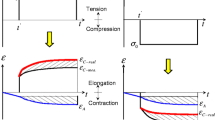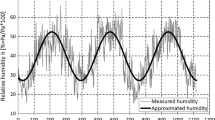Abstract
Concrete creep and shrinkage at cold temperatures are less significant than those at room temperature. For the structures exposed to subarctic weather, in situ creep and shrinkage strains are important factors in design process, such as estimating pre-stress losses, since ambient temperature and relative humidity change in a wide range. In the present study, the in situ creep and shrinkage strains were measured from high strength concrete specimens loaded in a concrete creep frame exposed to subarctic weather for 332 days. The measured creep strain was 23–30% of creep strain from specimens at room temperature. Also, the shrinkage strain was 67% of the shrinkage strain measured at room temperature. The comparison showed that the creep and shrinkage strains in real subarctic weather were larger than strains at a sustained cold temperature, but they were substantially smaller than strains at room temperature. The measured strains were compared with predicted values from widely used creep and shrinkage models. The AASHTO-LRFD model and the CEB MC90-99 model matched well with test results.










Similar content being viewed by others
References
Rüsch H (1960) Researches toward a general flexural theory for structural concrete. ACI-J Proc 57(7):1–28
ACI (2005) Report on factors affecting shrinkage and creep of hardened concrete (ACI 209.1R-05). American Concrete Institute, Farmington Hills
ACI (2008) Guide for modeling and calculating shrinkage and creep in hardened concrete (ACI 209.2R-08). American Concrete Institute, Farmington Hills
Byard BE, Schindler AK (2015) Modeling early-age stress development of restrained concrete. Mater Struct 48:435–450
Choi S, Cha SW, Oh BH (2010) Identification of viscoelastic behavior for early-age concrete based on measured strain and stress histories. Mater Struct 43:1161–1175
Rostásy FS, Schneider U, Wiedemann G (1979) Behaviour of mortar and concrete at extremely low temperatures. Cement Concrete Res 9(3):365–376
Montejo LA, Sloan JE, Kowalsky MJ, Hassan T (2008) Cyclic response of reinforced concrete members at low temperatures. J Cold Regions Eng-ASCE 22(3):79–102
Miura T (1989) The properties of concrete at very low temperatures. Mater Struct 22:243–254
Berner D, Gerwick BC Jr, Polivka M (1985) Static and cyclic behavior of structural lightweight concrete at cryogenic temperature. In: Naik TR (ed) Temperature effects on concrete. ASTM STP 85. American Society for Testing and Materials, Philadelphia, pp 21–37
Neville AM (2011) Properties of concrete, 5th edn. Pearson, New York
Elices M (1987) Cryogenic prestressed concrete: fracture aspects. Theor Appl Fract Mech 7:51–63
Lee GC, Shih TS, Chang KC (1988) Mechanical properties of concrete at low temperature. J Cold Regions Eng-ASCE 2(1):13–24
Lee GC, Shih TS, Chang KC (1988) Mechanical properties of high-strength concrete at low temperature. J Cold Regions Eng-ASCE 2(4):169–178
Montejo LA, Kowalsky MJ, Hassan T (2009) Seismic behavior of flexural dominated reinforced concrete bridge columns at low temperatures. J Cold Regions Eng-ASCE 23(1):18–42
Kogbara RB, Iyengar SR, Grasley ZC, Masad EA, Zollinger DG (2013) A review of concrete properties at cryogenic temperatures: towards direct LNG containment. Constr Build Mater 47:760–770
Kogbara RB, Iyengar SR, Grasley ZC, Rahman S, Masad EA, Zollinger DG (2016) Correlation between thermal deformation and microcracking in concrete during cryogenic cooling. NDT&E Int 77:1–10
Xie J, Chen X, Yan J-B, Lei G, Zhu L (2017) Ultimate strength behavior of prestressed concrete beams at cryogenic temperatures. Mater Struct 50:81
Johansen R, Best CH (1962) Creep of concrete with and without ice in the system. In: RILEM bulletin, pp 47–57
Turner FH (1980) Concrete and cryogenics—Part 1. Concrete 14(5):29–40
Browne RD, Bamforth PB (1981) The use of concrete for cryogenic storage: a summary of research, past and present. In: Cryogenic concrete: proceedings of the 1st international conference. The Concrete Society, pp 135–166
DeRosa D, Hoult NA, Green MF (2015) Effects of varying temperature on the performance of reinforced concrete. Mater Struct 48:1109–1123
Brewe JE, Myers JJ, Myers J (2008) Prestress loss behavior of high-strength self-consolidating concrete girders subjected to elevated compressive fiber stresses. In: National bridge conference
Garber DB, Gallardo JM, Deschenes DJ, Bayrak O (2016) Prestress loss calculations: another perspective. PCI J 68–85
Roller JJ, Russell HG, Bruce RN, Alaywan WR (2011) Evaluation of prestress losses in high-strength concrete bulb-tee girders for the Rigolets Pass Bridge. PCI J 56(1):110–134
AASHTO (2017) AASHTO LRFD bridge design specifications, 8th edn. American Association of State Highway and Transportation Officials
ASTM (2015) Standard test method for creep of concrete in compression (C 512/C512M-15). ASTM International
Vandermeer D, Ahn I-S (2019) Pre-stress loss due to creep in precast concrete decked bulb-tee girders under cold climate conditions. Center for Environmentally Sustainable Transportation in Cold Climates, University of Alaska Fairbanks, Fairbanks
ASTM (2014) Standard test method for static modulus of elasticity and Poisson’s ratio of concrete in compression (C469/C469M-14). ASTM International
AASHTO (2014) AASHTO LRFD bridge design specifications, 7th edn. American Association of State Highway and Transportation Officials
Tadros MK, Al-Omashi N, Seguirant SJ, Gallt JG (2003) Prestress losses in pretensioned high-strength concrete bridge girders (NCHRP report 496). Transportation Research Board, Washington
Acknowledgements
The present research was sponsored by the Center for Environmentally Sustainable Transportation in Cold Climates (CESTiCC) at University of Alaska Fairbanks. The opinions and conclusions expressed in this paper are those of the authors. They do not necessarily represent those of the sponsor.
Funding
The research was sponsored by the Center for Environmentally Sustainable Transportation in Cold Climates (CESTiCC) at University of Alaska Fairbanks.
Author information
Authors and Affiliations
Corresponding author
Rights and permissions
About this article
Cite this article
Vandermeer, D., Ahn, IS. In Situ Measurement of Concrete Creep and Shrinkage in Ambient Subarctic Weather. Int J Civ Eng 20, 475–485 (2022). https://doi.org/10.1007/s40999-021-00674-0
Received:
Revised:
Accepted:
Published:
Issue Date:
DOI: https://doi.org/10.1007/s40999-021-00674-0




